Hong Kong: Hong Kong is one of two special administrative zones in China, the other being Macau. It was handed over to the Chinese by the British in 1997 and, like Macau, will retain its special status for at least fifty years following the handover. China oversees foreign relations and defense, while the Hong Kong government handles the rest. Hong Kong is one of the most densely populated regions in the world and is today a leading international financial center.
The Portuguese were the first Europeans to arrive in Hong Kong, establishing settlements and military fortifications in the area, until being expelled by the Chinese. The Chinese banned contact with all foreigners and restricted local sea activity in the mid-1500s, not loosening its restrictions until 1685. Soon thereafter, the East India Company began trading in the region. Tensions between Britain and China led to the First Opium War in 1839 and, following the defeat of the Chinese, Hong Kong was ceded to Britain in 1842. British success in the Second Opium War resulted in the expansion of the territory to Kowloon Peninsula. Then, in 1898, Britain obtained a 99-year lease of lands adjacent to Kowloon, now known as the New Territories, and Lantau Island.
Getting There: We woke up and quickly headed over to the Hong Kong - Macau Ferry Terminal, a short distance from where we were staying, and purchased tickets for the trip from Macau to Hong Kong. We had to go through immigration before boarding the ferry, where we located our seat and buckled up for the trip to Hong Kong, which took about an hour. It was much like traveling in an airplane, only with larger windows and more legroom and headroom.
After arriving in Hong Kong, we exchanged some money for the Hong Kong dollar, then sat down and had breakfast before heading out to see the city. We couldn't find a good map online and there were none available at the ferry terminal, so it took us some time to get our bearings. We eventually found a map posted at the bus terminal in Central Hong Kong, on which we were able to locate our first destination. With the newfound information in mind, we headed out to the Victoria Peak Tramway.
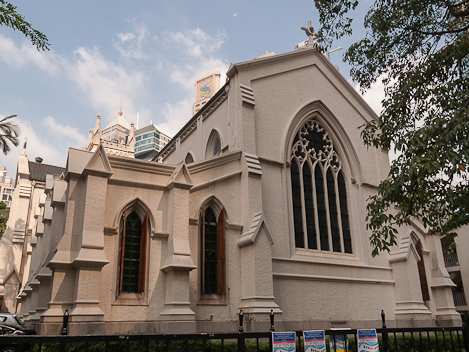
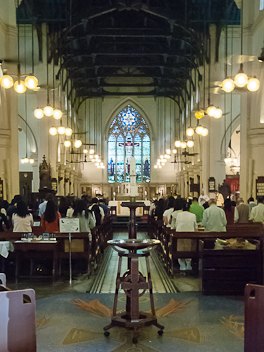
St. John's Cathedral: On our way to the tramway, we passed by St. John's Cathedral. Having held its first mass in 1849, St. John's is the oldest Anglican church in the Far East. It is also the only site in Hong Kong that is privately held, the remainder of the land belonging to the People's Republic of China and leased to its occupants. Mass was being held when we arrived, so we did not enter the building.

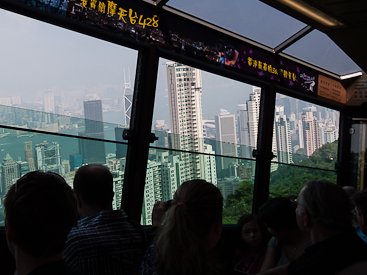
Victoria Peak Tramway:Continuing on, we arrived at the Victoria Peak Tramway, or rather the line for the tramway. After forty-five minutes in line, we had purchased our tickets and were taking our seats on the crowded tram. The Peak Tram was first opened in 1888 to ferry residents of Victoria Peak to and from the Central District, and was powered by a steam engine. That was later replaced by an electric engine. It was damaged during WWII and didn't operate for four years. In 1956, the electric motor trams were replaced by cars that were pulled up the hill by a cable attached to a motor under the lower terminus. The tramway was rebuilt in 1989, including new rails and tramcars. The Peak Tram now carries over 4 million riders between the Central District and Victoria Gap yearly.
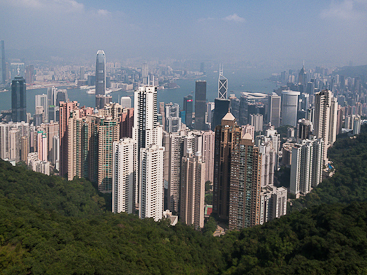
Victoria Peak: Stepping off the tram at the top, we found ourselves on the lower level of the Peak Tower, a shopping and leisure complex located at Victoria Gap. We made our way upstairs, past all the restaurants and souvenir shops, and stepped out onto the viewing platform, where we were treated to views of Hong Kong all around us. Even though it was hazy the day we were there, we could still see Central Hong Kong, Victoria Harbor and Kowloon below. After soaking in the views, we returned to the tram terminus for the ride back down the mountain. Fortunately, the line for the descent was much shorter than the one for the ascent, it being only half past noon.
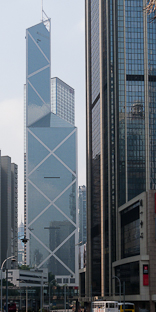
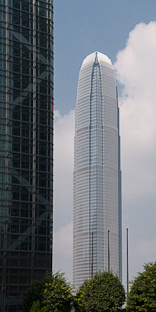
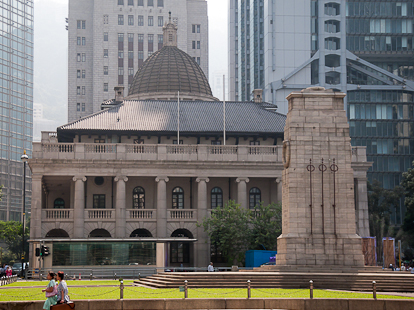
Downtown Hong Kong: We next entertained ourselves with a walking tour of downtown Hong Kong, admiring the architecture of such buildings as the Bank of China Tower, Central Plaza, International Finance Center (IFC), and the Legislative Council Building, among others. Travelling on foot in downtown Hong Kong was difficult. To get across many of the busy streets, an elevated walkway was provided. However, finding the stairway up to the walkway was challenging, sometimes located inside a nearby building and other times half a block away. We even found ourselves walking the equivalent of two blocks just to cross the street.
With several activities on our agenda and not enough time to get to them all, we decided to go see the Tian Tan Buddha Statue on Lantau Island. The only map we did have on hand was of the subway system, so we eventually made our way to where we thought a station was located. As we got close we saw many signs directing us to the different shopping complexes in the area, but none to the subway. Finally, we asked someone, who pointed us to the nearby station. The only sign was that of the symbol for the underground metro located just above the steps leading down to the station. We purchased our tickets and found a seat on the train where we could get off our feet for the trip to Lantau Island and Ngong Ping 360.
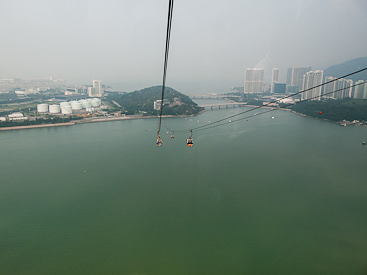
Ngong Ping 360:Ngong Ping 360 is a tourism attraction located on Lantau Island and consists of a cable car and a tourist village. From the metro station it was a short walk to the lower station for the cable car, where we again waited in line to purchase tickets and board our gondola for the trip up to the Ngong Ping plateau. Once on board, we got stunning views of the Hong Kong International Airport, Tung Chung Bay, and an early peek at the Tian Tan Buddha Statue.
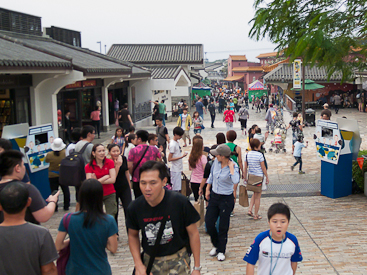
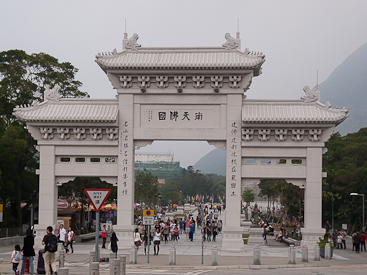
Ngong Ping Village & Ngong Ping Piazza: Having arrived at the end of the cable car ride, we stepped out of the gondola and into Ngong Ping Village, a newly constructed village of traditional Chinese buildings housing restaurants, souvenir shops and a couple of shows. We wove our way through the crowds into the Ngong Ping Piazza at the far end of the village. The Piazza contains an entrance gate, walkway, gardens, and statues of the "Twelve Divine Generals", regarded as protectors in Buddhism.
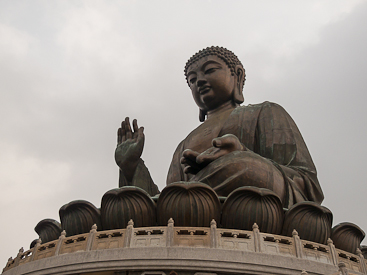

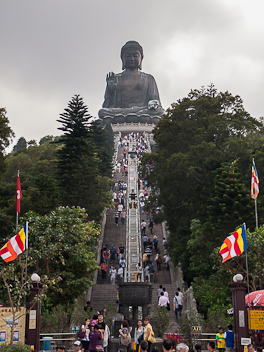
Tian Tan Buddha Statue: At the far end of the piazza was the bottom of 240 steps leading up to the Tian Tan Buddha Statue. It was named Tian Tan Buddha because its base is modeled after Tian Tan (Altar of Heaven) in Beijing. The triple-tiered base upon which the lotus throne of the Buddha sits contains three halls, which we did not enter. In front of the statue are six smaller bronze statues of devas making offerings to the Buddha.
Having witnessed earlier the long line that had formed to board the gondola for the ride down the mountain, we decided to begin our return trip. While I saved our place in line, Peep went and purchased a snack for us to enjoy during the wait. After she returned, I quickly made my way back trough the village and piazza to get some pictures of Po Lin Monastery.
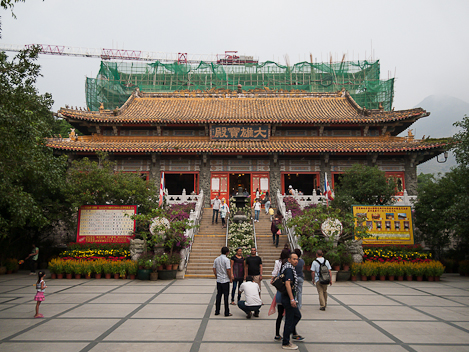
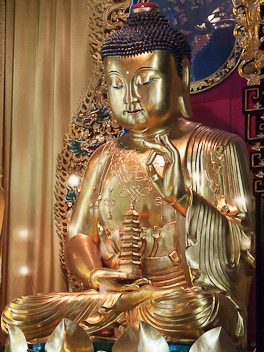
Po Lin Monastery: Founded in 1906 by three Buddhist monks from mainland China, the monastery was originally known as the "Big Thatched Hut". Renamed Po Lin in 1924, it continued to grow in popularity. The monastery holds three bronze statues of Buddha, representing his past, present and future lives. Still under construction is a large building that will house the Hall of Ten Thousand Buddhas, Scripture Library, Abbot's Chamber, Dharma Hall and a permanent Ordination Platform upon its completion in 2012.
After viewing Po Lin Monastery, I rushed back to find Peep standing just outside the stanchions marking the final approach to the gondola loading platform. The sunlight was fading fast as we descended the mountain from Ngong Ping to Tung Chung, and then to the metro station for the train ride back. However, we did not ride all the way to Central, but rather got off one stop earlier at Kowloon.

Kowloon: Kowloon peninsula sits on the opposite side of Victoria Harbor from Hong Kong Island, and became a part of Hong Kong in 1860 following the Second Opium War. The subway station was located in the middle of a shopping mall, so we began looking for a way out. The only exits we were able to find on our own emptied out to a taxi cab station and a parking garage, so we had to ask and were told to descend the escalator and go past the ice rink, where we finally saw the exit sign. We headed outside and got a expansive view of a construction fence. We eventually made our way to a harborside park where the Hong Kong Wine & Dine Festival was being held. Admission was free, so we entered and located a spot between the vendor tents where we finally got a view of the Hong Kong skyline.
Dinner & Return to Macau: Rather than eating at the festival, where there were no tables set up, forcing people to sit on the steps to eat, we returned to the mall and found a bar and grill for dinner. After our meal, we took the metro back to Central, walked to the Hong Kong - Macau Ferry Terminal, purchased tickets, went through immigration, and made the return trip to Macau, arriving just before midnight.
Trip Home: The next morning we took a taxi to the airport for our flight to Bangkok, where we had another long layover before our flight to Ubon Ratchatani. From the airport, we took the shuttle bus to Mukdahan, where we spent the night, having landed too late to cross the bridge to Savannakhet. On Monday morning, Peep's assistant from work arrived at the hotel, and we stopped for groceries before returning to Laos.

